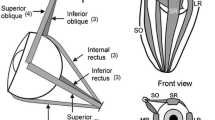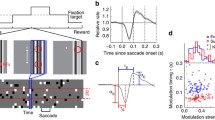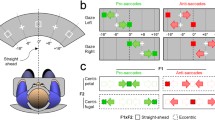Summary
A quantitative study of saccadic eye movements in the cat was undertaken to attempt to account for the high degree of variability in the trajectory of feline saccades compared with the more stereotyped monkey saccades. Cats were trained to make oblique saccades so that a large variety of saccadic component amplitudes, maximum velocities, and durations could be obtained.
The horizontal and vertical components of oblique saccades were either stretched or compressed, relative to equal amplitude movements without orthogonal components, so that the two components were nearly equal in duration. On average, the components began approximately synchronously but were more asynchronous in their termination times. Consistent with the stretching or compression of a saccadic component, there was the complementary decrease or increase respectively of its maximum velocity. The product of maximum velocity and duration was constant for saccades of a given size. Furthermore, the constant relating maximum velocity and duration was a linear function of saccade size. Therefore, any saccade size was uniquely determined by knowing both duration and maximum velocity while knowing either alone resulted in considerable ambiguity in specifying saccade size.
In addition to uniquely specifying feline saccades with different degrees of obliquity, this two parameter description allowed us to fit not only the monkey data but data obtained from rabbit and human as well. Therefore, specification of both duration and maximum velocity might be a basic organizing principle of the neural mechanisms generating saccades in many species.
Similar content being viewed by others
References
Bahill TA, Clark MR, Stark L (1975) The main sequence, a tool for studying human eye movements. Math Biosci 24: 191–204
Bahill TA, Stark L (1977) Oblique saccadic eye movements. Arch Ophthalmol 95: 1258–1261
Bahill TA, Stark L (1975) Neurological control of horizontal and vertical components of oblique saccadic eye movements. Math Biosci 27: 287–298
Baker R, Berthoz A (eds) (1977) Control of gaze by brainstem neurons. Elsevier, New York
Baloh RW, Sills AW, Kumley WE, Honrubia V (1975) Quantitative measurement of saccade amplitude, duration and velocity. Neurology 25: 1065–1070
Berkley MA (1970) Visual discriminations in the cat. In: Stebbins WC (ed) Animal psychophysics. Appleton, New York, pp 231–248
Collewijn H (1977a) Gaze in freely moving subjects. In: Baker R, Berthoz A (eds) Control of gaze by brainstem neurons. Elsevier, New York, pp 13–23
Collewijn H (1977b) Eye and head movements in freely moving rabbits. J Physiol (Lond) 266: 471–498
Cook B, Stark L (1968) Dynamic behavior of the human eye-positioning mechanism. Commun Behav Biol 1: 197–204
Crommelinck M, Roucoux A (1976) Characteristics of cat's eye saccades in different states of alertness. Brain Res 103: 574–578
Dodge R (1903) Five types of eye movements in the horizontal meridian plane of the field of regard. Am J Physiol 8: 307–329
Dodge R, Cline TS (1901) The angle velocity of eye movements. Psychol Rev 8: 145–157
Donaghy MJ (1975) The role of vestibular feedback in the control of gaze changes accomplished by coordinated eye and head movements. Exp Brain Res [Suppl] 23: 227
Evinger C, Fuchs AF (1978) Saccadic smooth pursuit, and optokinetic eye movements of the trained cat. J Physiol (Lond) 285: 209–229
Evinger LC, Fuchs AF, Baker R (1977) Bilateral lesions of the medial longitudinal fasciculus in monkeys. Effects on the horizontal and vertical components of voluntary and vestibular induced eye movements. Exp Brain Res 28: 1–20
Evinger C, Kaneko CRS, Johanson GW, Fuchs AF (1977) Omnipauser cells in the cat. In: Baker R, Berthoz A (eds) Control of gaze by brainstem neurons. Elsevier, New York, pp 337–340
Fuchs AF (1971) The saccadic system. In: Bach-y-Rita P, Collins CC, Hyde JE (eds) The control of eye movements. Academic Press, New York, pp 343–362
Fuchs AF (1976) Saccadic and smooth eye movements in the monkey. J Physiol (Lond) 191: 609–631
Fuchs AF, Robinson DA (1966) A method for measuring horizontal and vertical eye movement chronically in the monkey. J Appl Physiol 21: 1068–1070
Goebel HH, Komatsuzaki A, Bender MB, Cohen B (1971) Lesions of the pontine tegmentum and conjugate gaze paralysis. Arch Neurol 24: 431–440
Haddad BM, Robinson DA (1977) Cancellation of the vestibuloocular reflex during active and passive head movements in the normal cat. Neurosci Abst 3: 477
Halmagyi GM, Evans, WA, Hallinan JM (1978) Failure of downward gaze. The site and nature of the lesion. Arch Neurol 35: 22–26
Hassler R (1972) Supranuclear structures regulating binocular eye and head movements. Bibl Ophthalmol 82: 207–219
Henn V, Cohen B (1976) Coding of information about rapid eye movements in the pontine reticular formation of alert monkeys. Brain Res 108: 307–325
Hyde JE (1959) Some characteristics of voluntary human ocular movements in the horizontal plane. Am J Ophthalmol 48: 85–94
Kaneko CRS, Evinger C, Fuchs AF (1977) Bursting eye-movement related neurons recorded in the brainstem of the alert trained cat. Neurosci Abst 3: 479
Keller EL (1974) Participation of the medial pontine reticular formation in eye movement generation in the monkey. J Neurophysiol 37: 316–332
King WM, Fuchs AF (1979) Reticular control of vertical saccadic eye movements by burst neurons. J Neurophysiol 42: 861–876
King WM, Fuchs AF (1977) Neuronal activity in the mesencephalon related to vertical eye movements. In: Baker R, Berthoz A (eds) Control of gaze by brainstem neurons. Elsevier, New York, pp 319–327
Kömpf D, Pasik T, Pasik P, Bender M (1979) Downward gaze in monkeys. Stimulation and lesion studies. Brain 102: 527–558
Luschei ES, Fuchs AF (1972) Activity of brainstem neurons during eye movements of alert monkeys. J Neurophysiol 35: 445–461
Mackensen G (1958) Die Geschwindigkeit horizontaler Blickbewegungen. Untersuchungen mit Hilfe der Electrooculographie. Graefes Arch Ophthalmol 160: 47–64
Pasik T, Pasik P, Bender MB (1969) The pretectal syndrome in monkeys. I. Disturbance of gaze and body posture. Brain 92: 521–534
Robinson DA (1972) Eye movements evoked by collicular stimulation in the alert monkey. Vision Res 12: 1795–1808
Robinson DA (1963) A method of measuring eye movement using a scleral search coil in a magnetic field. IEEE Trans Bio Med Electron 10: 137–145
Robinson DA, Fuchs AF (1969) Eye movements evoked by stimulation of frontal eye fields. J Neurophysiol 32: 637–648
Schiller PH, Stryker M (1972) Single-unit recording and stimulation in superior colliculus of the alert rhesus monkey. J Neurophysiol 35: 915–924
Sharpe JA, Alex WL, Rabinovitch HE (1979) Control of the saccadic and smooth pursuit system after hemidecortication. Brain 102: 387–403
Stryker MP, Blakemore C (1972) Saccadic and disjunctive eye movements in cats. Vision Res 12: 2005–2013
Stryker MP, Schiller PH (1975) Eye and head movements evoked by electrical stimulation of monkey superior colliculus. Exp Brain Res 23: 103–112
Viviani P, Berthoz A, Tracey D (1977) The curvature of oblique saccades. Vision Res 17: 661–664
Author information
Authors and Affiliations
Additional information
This work was supported by NIH Grants RR-00166, EY-00745, and NS-05082
Rights and permissions
About this article
Cite this article
Evinger, C., Kaneko, C.R.S. & Fuchs, A.F. Oblique saccadic eye movements of the cat. Exp Brain Res 41, 370–379 (1981). https://doi.org/10.1007/BF00238895
Received:
Issue Date:
DOI: https://doi.org/10.1007/BF00238895




